This is not the most interesting topic to address when promoting the world of hot water therapy and relaxation, but with my 25 years of experience (2019), I have a lot of insights on the promotion of different systems.
First off, I’m no chemist – but I know the benefits of hot, clean and clear water. Secondly, I have witnessed over 25 years of “sales organizations” promoting products and systems intended specifically to “sell” a consumer on their products. I am a firm believer in not “overselling” a product – the term “under promise” and “over deliver” comes to mind.
Cost of ownership is a topic discussed weekly in our business and frankly, it is a topic we discuss in our household as well. When purchasing anything, I always analyze the long-term costs and benefits. The same is true for a major purchase such as a hot tub or swimming pool. For this article, I will address the hot tub. The intention of the cost of ownership discussion for the hot tub will be directed towards water quality, in the next article we’ll discuss electrical costs.
Back in 1994 when I started Midnight Sun Pools n’ Spas, I was instructed to purchase a floater and fill it with bromine tablets, which I did. I remember the water quality upon the initial fill up was wonderful, it was clear and clean and did not smell! Quickly, however, I noticed the water would turn white and fizz while the jets were on. It also had an odor that I did not care for. I knew there had to be a better way.
That original system in 1994 was wonderful at the cash register for the business! They promoted expensive bromine tablets, for a Monday, Wednesday, Friday, Saturday program of chemicals that consisted of eight different bottles to purchase. Fast forward three years, that program did not make any sense both financially, or for the water quality and it was time-consuming!
Around 1998, I helped start a multi-purpose chemical that performed multiple actions in one 2-oz dosage for the typical hot tub. It eliminated the need for the M, W, F, S program and the multiple bottles. Around 1997, I started to study chlorine (exciting!) and I discovered that there were five major types of chlorine.
Chlorine has a bad reputation. People label it as smelly and something that makes your skin itch and discolors your hair. Actually, it is the improper use of chlorine and the disregard of PH levels and non-chlorine shock that gives chlorine a bad reputation. Also, those factors combined with the improper chlorine not designed for small bodies of hot water (hot tubs) are the perfect storm for a bad water quality experience.
Look at the active ingredients. Quality hot tub chlorine (sodium dichlor) is a granular designed for quick dissipation in a hot tub. This product, combined with the once a week multi-purpose chemical, once a week “non-chlorine” shock (potassium peroxy-monopersulfate) and proper PH levels (7.2 to 7.6) will give you clean, clear, soft water. The cost of ownership and your time allocation is the perfect mix to allow you to enjoy your purchase. We also enjoy adding salt fragrances from time to time to enhance our experience.
Our customers enjoy this method as it allows them to maintain a very low level of chlorine, typically 1ppm or less – combined with our Ultra Violet (UV) sterilization system they enjoy clean, clear sanitized water for a very low cost.
The UV water purification system is wonderful. It processes 35 gallons per minute through the sterilization system. Typically, in a normal household, the UV system will disable 95 percent of the natural warm water and introduced bacteria. It is here, where we add the Sodium Dichlor to counter the five percent in order to maintain the clean, clear water you expect.
The cost of ownership for a Jacuzzi® Premium Ultraviolet System is very low compared to major competitors systems. In order to maintain your Jacuzzi® UV system, we recommend purchasing and replacing your UV bulb once a year. The cost of the bulb is currently $63.20 for our customers and is very easy to replace.
Besides bromine-based systems which I discussed earlier, I also tried the salt water systems from 2006 to 2009.
Before I begin the discussion of salt water systems, we need to address the “sales organizations” selling these systems. Salt water does not disinfect or clean water. Salt water systems should be called what they really are, chlorine generators. Anyone promoting these systems as chemical free, or easier on your skin, really should spend a few years on the service side of the industry to learn the cause and effect of the systems.
With in-ground pools, I liked the system – a large body of cool water combined with the fact that our IG pool customers hired us for services to open and close their pools was, at the time a formula for success. At closings, our technicians would dis-assemble the salt water systems and have to clean them. Typically, northern Minnesota is a “hard water” area. The source water was causing “clogging” of the salt cell which severely reduced the chlorine output. We have since stopped installing salt systems on pools because of the severe corrosion of automatic pool covers as well as other metals at the pool area. We can discuss that another time. But any due diligence you perform, you will see that nationwide that is the industry consensus.
When you add water and salt together, you have the ingredients needed to produce chlorine. Before you start producing the chlorine, you need to break apart the molecules. This is done through electrolysis. The water is being pumped through the chamber which holds two electrified platinum or titanium plates (salt cell) one is positively charged, and one is negatively charged. The low electrical current causes the water and salt molecules to break up and recombine into hypochlorous acid and sodium hydroxide. Hypochlorous acid is pure chlorine (sound fun?) and instantly starts killing bacteria at a rate of 3 to 5ppm of chlorine in the water compared to less than 1ppm with a typical sodium dichlor and Ultra Violet sanitization system. Once the hypochlorous acid pure chlorine has done its work in the salt water spa, it converts back to chloride and recombines with sodium to form salt once again in a repeat process.
Simply put, you add the special salt to the hot tub, turn on the salt device and as water is pumped through the device an amount of chlorine comes out the other end.
Let’s revert back to the cost of ownership in our purchases and why after three years of working with Salt Water Pools and Spas, I steered my company away from introducing these systems to our clients.
The life span of a salt system maintained properly is one to five years. The cost to replace the system is between $800 wholesale and $1500 retail. In our Northern Minnesota hard water environment, I witnessed our customers having to remove their system and clean the plates monthly in order to maintain the production of a suitable amount of chlorine needed to sanitize the hot tub. Needless to say, the long-term cost of ownership and the time investment was not worth it for many.
Corrosive. Yes, the manufacturing sales guys told me that it’s such a low level, it will not be corrosive. Reality is, even at levels of 2500 ppm damage occurred to shiny finishes and soft rubber parts. Again, what was really bad for the system was our high levels of iron in our source water. Galvanic corrosion made it easier for spa staining to occur and I saw it firsthand.
Consumers were coming to us willing to spend any amount of money to have a salt water hot tub! Why? They said they were allergic to chlorine and could not have chlorine. After some education with the consumer, talking about how salt systems really should be called chlorine generators, I came to find out they had visited a “sales organization” typically at an event and had been sold on salt by a salesman.
Owning a hot tub or spa is a wonderful investment in your lifestyle, for both health and family time. Take into consideration the long-term benefits of the system you choose, and who you choose to do business with. Never buy anything based upon the promise of the water you may have.
To sum up, keep your PH in balance (7.2 to 7.6) because the PH of your skin is balanced (7.2 to 7.6), that alone will give you soft skin and protect your spa equipment from corrosion for many years to come!




